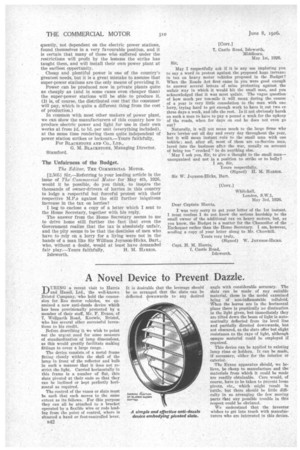A Novel Device to Prevent Dazzle.
Page 26

If you've noticed an error in this article please click here to report it so we can fix it.
TIERING a recent visit to Harris 1...F and Hasell, Ltd., the well-known Bristol Company, who hold the concession for Roo motor vehicles, we examined a new anti-dazzle device which has been provisionally protected by a member of their staff, Mr. F. Evans, of 7, Wellgarth Road, Knowle, Bristol, who has several other successful inventions to his credit.
Before describing it we wish to point out the urgent need for some measure of standardization' of lamp dimensions, as thiS would greatly facilitate making fittings to cover a large range.
The device consists.of a metal frame fitting closely within the shell of the lamp in front of the reflector and bulb in such a manner that it does not restrict thelight. Carried horizontally in this frame is a number of flat, thin slats pivoted at their ends so that they can be inclined or kept perfectly horizontal as required.
The control of the vanes or slats must be such that each moves to the same extent as it fellows. For this purpose they can all be attached to a bracket operated by a flexible wire or rods leading from the point of control, where is situated a hand or foot-controlled lever.
1342 It is desirable that the leverage should be so arranged that the slats can be deflected downwards to any desired angle with considerable accuracy. The slats can be made of any suitable material, those in the model examined being of non-inflammable celluloid. When the leaves are in the horizontal plane there is practically no diminution in the light given, but immediately they are tilted down the beam of light is automatically deflected from its level line and partially directed downwards, but not obscured, as the slats offer but slight resistance to the rays of light, although opaque material could be employed if required.
This device can be applied to existing lamp rims or holders. It can be made, if necessary, either for the interior or exterior.
The Evans apparatus should, we believe, be cheap to manufacture and the materials from which it could be made are readily obtainable. Care would, of course, have to be taken to prevent loose pivots, etc., which might 'result in rattle, but there should be little difficulty in so arranging the few moving parts that any possible trouble in this respect could be obviated.
• We understand that the inventor wishes to get into touch with manufacturers who are interested in this device.




























